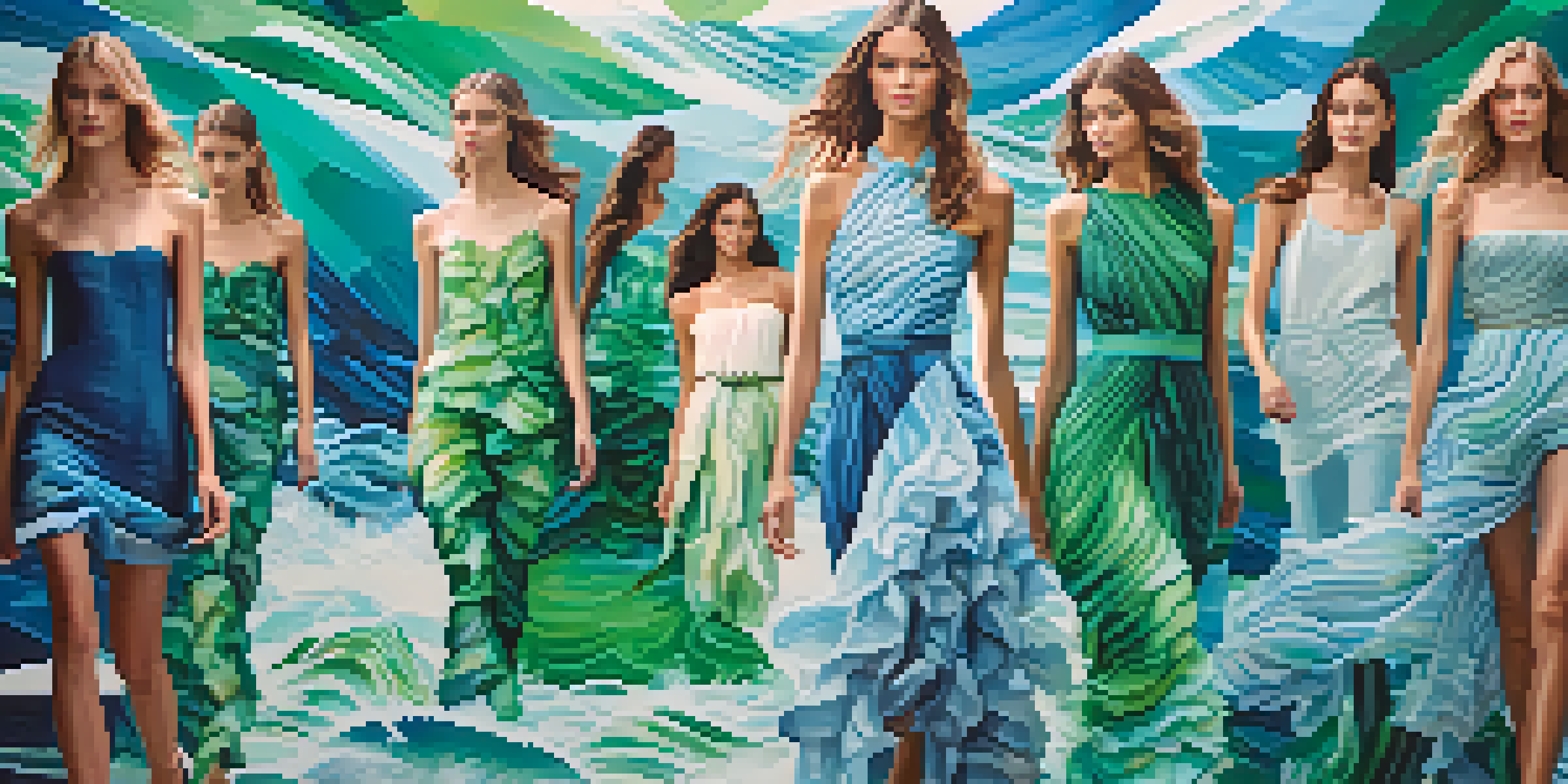The Intersection of Fashion and Climate Change in Art

Understanding Climate Change and Its Impact on Fashion
Climate change is not just an environmental issue; it profoundly affects various industries, including fashion. As global temperatures rise, the resources needed for textile production, such as water and cotton, become increasingly scarce. Moreover, the fashion industry is notorious for its significant carbon footprint, making it crucial to explore sustainable practices. By understanding these impacts, both consumers and creators can make more informed choices.
Fashion is the armor to survive the reality of everyday life.
Fashion's relationship with climate change also extends to the materials used. Traditional fabrics often require extensive resources to produce, which leads to environmental degradation. In contrast, sustainable alternatives, such as organic cotton or recycled materials, are gaining traction. This shift not only benefits the planet but also encourages designers to innovate creatively, blending aesthetic appeal with eco-friendliness.
Artists and designers are now stepping up to address these issues head-on. By incorporating themes of sustainability and climate awareness into their work, they can spark conversations and inspire action. This intersection of art and fashion serves as a powerful platform for raising awareness about climate change and promoting responsible consumer behavior.
Art as a Medium for Climate Activism in Fashion
Art has always been a compelling means of communication, and when it intersects with fashion, it can amplify messages about climate change. Designers and artists are using their platforms to create pieces that not only look good but also tell a story about environmental issues. For instance, garments made from upcycled materials often carry narratives about waste and sustainability.

The creativity found in art allows for unique expressions of urgency regarding climate change. Fashion shows can serve as performances that highlight the impact of environmental degradation, making the audience not just viewers but participants in the narrative. This immersive experience can leave a lasting impression, prompting individuals to rethink their relationship with clothing and consumption.
Climate Change Impacts Fashion Choices
The fashion industry faces significant challenges due to climate change, prompting a shift towards sustainable practices and materials.
Moreover, collaborative projects between artists and fashion designers are becoming increasingly common. These partnerships can produce stunning visuals that challenge traditional notions of beauty and consumption while also promoting sustainable practices. By merging their talents, they create a more significant impact, encouraging a shift towards eco-conscious fashion.
Innovative Materials Changing the Fashion Landscape
As the fashion industry seeks to reduce its carbon footprint, innovative materials are at the forefront of this transformation. From biodegradable fabrics to lab-grown leather, designers are finding ways to create eye-catching pieces without harming the environment. This evolution in material science not only appeals to eco-conscious consumers but also pushes the boundaries of creativity in fashion.
The future is not something we enter. The future is something we create.
For example, brands are experimenting with fabrics made from recycled ocean plastic to create chic swimwear and accessories. This not only helps reduce waste but also raises awareness about plastic pollution in our oceans. Such initiatives serve as a reminder that fashion can be both stylish and sustainable, inspiring consumers to support brands that prioritize the planet.
Additionally, the rise of digital fashion is revolutionizing the industry. Virtual clothing allows for endless creativity without the environmental costs associated with traditional production. As more designers explore this avenue, the concept of fashion continues to evolve, demonstrating that sustainability and innovation can go hand in hand.
The Role of Fashion in Reflecting Environmental Issues
Fashion has a unique ability to mirror societal concerns, including climate change. Designers often draw inspiration from environmental crises, using their collections to comment on issues like deforestation, pollution, and climate justice. This reflective nature of fashion can lead to increased awareness and dialogue about pressing environmental challenges.
For instance, collections inspired by natural disasters or endangered ecosystems can provoke emotional responses, encouraging consumers to engage with these issues on a deeper level. By showcasing the stark realities of climate change through their designs, fashion creators can motivate individuals to take action, from supporting sustainable brands to advocating for policy changes.
Art Drives Climate Awareness in Fashion
Collaborations between artists and designers are creating impactful fashion pieces that raise awareness about environmental issues.
Moreover, fashion weeks and exhibitions increasingly feature themes centered around sustainability. By placing these issues at the forefront, the industry signals a shift in priorities, demonstrating that environmental consciousness is not just a trend but an essential aspect of modern fashion. This evolution can inspire future generations of designers to continue exploring the intersection of fashion and climate change.
The Impact of Consumer Choices on Sustainable Fashion
Consumer behavior plays a pivotal role in shaping the fashion industry. As awareness of climate change grows, shoppers are becoming more mindful of their purchasing decisions. This shift towards conscious consumerism encourages brands to adopt sustainable practices, as they are increasingly held accountable by their customers.
By choosing to support ethical brands that prioritize sustainability, consumers can drive significant change. This can include opting for second-hand clothing, investing in high-quality pieces that last longer, or selecting items made from eco-friendly materials. Every small choice contributes to a larger movement towards responsible fashion, demonstrating the power of individual actions.
Moreover, social media has amplified the voices of eco-conscious consumers, allowing them to share their values and preferences with a broader audience. This collective effort can influence trends and encourage brands to prioritize sustainability in their collections. As consumers continue to advocate for change, the fashion industry must adapt to meet these demands, creating a more sustainable future.
Collaborations Between Artists and Fashion Designers
Collaborations between artists and fashion designers are becoming increasingly popular, creating a fusion of creativity that highlights climate issues. These partnerships can bring fresh perspectives to fashion, allowing for innovative designs that make bold statements about sustainability. By combining artistic vision with fashion expertise, they can create pieces that resonate on both aesthetic and emotional levels.
For instance, some designers have partnered with visual artists to produce limited-edition collections that feature striking graphics inspired by environmental themes. These pieces not only stand out in the fashion landscape but also serve as wearable art that raises awareness about climate change. Such collaborations can inspire consumers to think critically about their fashion choices while also celebrating artistic expression.
Consumer Choices Shape Sustainable Fashion
As shoppers become more eco-conscious, their purchasing decisions are driving brands toward adopting sustainable practices.
Additionally, these joint ventures often extend beyond the product itself. Events or exhibitions featuring these collaborations can further educate the public about sustainability in fashion. By fostering connections between artists and designers, the industry can promote a culture that values creativity and environmental consciousness, paving the way for a more sustainable future.
Future Trends in Eco-Conscious Fashion and Art
Looking ahead, the intersection of fashion and climate change in art is likely to evolve further. As technology advances, we may see even more innovative solutions to sustainable fashion challenges. For example, the rise of 3D printing could transform production methods, reducing waste and allowing for customizable designs that cater to individual preferences.
Moreover, the trend toward transparency in the fashion supply chain is gaining momentum. Consumers increasingly demand to know the origins of their clothing, pushing brands to disclose information about their sourcing and manufacturing processes. This shift towards accountability is essential in fostering trust and encouraging sustainable practices across the industry.

Finally, as climate change continues to dominate global conversations, we can expect fashion to remain a powerful tool for advocacy. Designers and artists will likely keep using their platforms to address environmental issues, sparking critical discussions that inspire change. By embracing these evolving trends, the fashion industry can contribute to a more sustainable and conscious future.